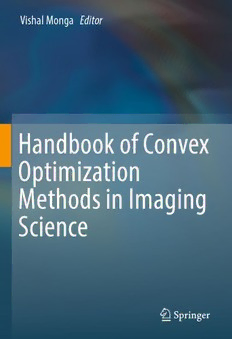
Handbook of convex optimization methods in imaging science PDF
Preview Handbook of convex optimization methods in imaging science
Vishal Monga Editor Handbook of Convex Optimization Methods in Imaging Science Handbook of Convex Optimization Methods in Imaging Science Vishal Monga Editor Handbook of Convex Optimization Methods in Imaging Science 123 Editor VishalMonga ThePennsylvaniaStateUniversity UniversityPark,PA,USA ISBN978-3-319-61608-7 ISBN978-3-319-61609-4 (eBook) DOI10.1007/978-3-319-61609-4 LibraryofCongressControlNumber:2017952608 ©SpringerInternationalPublishingAG2017 Thisworkissubjecttocopyright.AllrightsarereservedbythePublisher,whetherthewhole orpartofthematerialisconcerned,specificallytherightsoftranslation,reprinting,reuseof illustrations,recitation,broadcasting,reproductiononmicrofilmsorinanyotherphysicalway, andtransmissionorinformationstorageandretrieval,electronicadaptation,computersoftware, orbysimilarordissimilarmethodologynowknownorhereafterdeveloped. Theuseofgeneraldescriptivenames,registerednames,trademarks,servicemarks,etc.inthis publication doesnotimply,evenintheabsenceofaspecificstatement,thatsuchnamesare exemptfromtherelevantprotectivelawsandregulationsandthereforefreeforgeneraluse. Thepublisher,theauthorsandtheeditorsaresafetoassumethattheadviceandinformationin thisbookarebelievedtobetrueandaccurateatthedateofpublication.Neitherthepublisher northeauthorsortheeditorsgiveawarranty,expressorimplied,withrespecttothematerial containedhereinorforanyerrorsoromissionsthatmayhavebeenmade.Thepublisherremains neutralwithregardtojurisdictionalclaimsinpublishedmapsandinstitutionalaffiliations. Printedonacid-freepaper ThisSpringerimprintispublishedbySpringerNature TheregisteredcompanyisSpringerInternationalPublishingAG Theregisteredcompanyaddressis:Gewerbestrasse11,6330Cham,Switzerland ThisbookisdedicatedtoMr.VijayChaudhary, whoremainsaconstantsourceofsupport andencouragement. Preface The value of mathematical optimization to engineering cannot possibly be overstated. Engineering and applied math problems invariably involve minimizationofanerrororcostfunction,oralternativelythemaximizationof thelikelihoodofsuccess.Theoptimalchoiceofreal-worldphysicalvariables or design parameters that enable the best minimization/maximization is hence crucial. Often these parameters are constrained by physical laws, the available memory and/or computation, the requirements of fast or real- timeoperation,etc.Thisbookstudiesoptimizationtechniques,inparticular convexoptimizationmethodsandalgorithms,forthehighimpactengineering domainofimagingscience.Imagingscienceconcernsitselfwithallaspects ofimageacquisition,processing,rendering,andtransmission.Theeconomic footprint of imaging and vision systems is quite significant and continues togrow.Technologyfueledbyoptimizationalgorithmsinimageprocessing andvisioncanbefoundinsmartphones,cameras,displays,medicalimaging devicesandsoftware,remote-sensingmachineryandsatellites,robotics,and defenseandaerospaceproductstonameafew. This book is an outgrowth of my individual research and teaching in the intersection of convex optimization and imaging science. Truthfully, I havebeencajoledintowritingitbyseveraldistinguishedcolleaguesengaged in computational aspects of image processing and vision, whose work I admiregreatly.Theareasofimageprocessingandcomputervisionbenefitted tremendouslyfromtheappliedmathsubsetsoflinearalgebraandprobability in the 1980s to early 2000s. I am firm on the view that an in-depth under- standing of optimization and the opportunities it presents in solving real- worldimagingproblemsisimperativeforthemodernresearcherinthisarea. ThebookishenceaimedatgraduateandundergraduatestudentsinElectrical Engineering,ComputerScience,AppliedPhysics,andMathematics.Because thebookisaneditedvolumewithstate-of-the-artcoverageofmanyimaging scienceproblemsfromacomputationalviewpoint,itshouldalsobeofvalue toindustrialresearchersandpractitioners. UniversityPark,PA,USA VishalMonga vii Acknowledgments Iamgratefultoallmycolleagueswhohavekindlycontributedhigh-quality andthoroughchapterstothisbook.Intermsofwritingandorganization,this wasunchartedterritory,whichmakestheireffortsevenmorecommendable. Other than the contributors, many notable senior researchers in the signal andimageprocessingareahavebeenimmenselysupportiveandencouraging and have made this book possible; this includes (but is not limited to) Charlie Bouman at Purdue, Trac Tran at Johns Hopkins, P.P. Vaidyanathan atCalTech,andMuralidharRangaswamyattheUSAirForceResearchLab. The book would not have come about if not for the excellent research and educational efforts of my doctoral students and alumni of the Information Processing and Algorithms Laboratory (iPAL) (http://signal.ee.psu.edu) at Penn State. Umamahesh Srinivas and Hojjat Mousavi have helped cowrite a chapter with me on sparsity-constrained optimization and estimation and havealsohelpedmeorganize,plan,andultimatelyexecutethevisionforthis book—myspecialthankstothem. I would greatly appreciate hearing of any errors that may be found in the book for reasons beyond my control and that of the publisher. I take responsibility for any limitations that the book may have and invite [email protected]. UniversityPark,PA,USA VishalMonga ix Contents 1 Introduction ............................................. 1 VishalMonga 1.1 ConvexOptimizationinImagingScience ................. 1 1.2 ConvexOptimizationReview ........................... 3 1.2.1 ConvexSets ................................... 3 1.2.2 ConvexFunctions .............................. 4 1.2.3 ConvexOptimization............................ 5 1.2.4 ConvexOptimizationProblems:Examples.......... 5 1.2.5 OptimizationMethods........................... 6 1.2.5.1 LagrangeMultipliersandDuality ......... 6 1.2.5.2 DescentMethods ....................... 7 1.2.5.3 IterativeThresholdingMethods ........... 8 1.2.5.4 AlternativeDirectionMethod ofMultipliers .......................... 8 1.2.6 HandlingNon-convexProblems................... 9 1.3 BookOutline......................................... 12 References................................................ 13 2 OptimizingImageQuality ................................. 15 Dominique Brunet, Sumohana S. Channappayya,Zhou Wang, EdwardR.Vrscay,andAlanC.Bovik 2.1 Introduction.......................................... 15 2.1.1 ImageQualityAssessmentMeasures .............. 15 2.1.2 PerceptualOptimizationFramework ............... 17 2.1.3 ChapterOverview .............................. 18 2.2 MathematicalPropertiesoftheSSIMIndex ............... 18 2.2.1 StructuralandNon-StructuralDistortions........... 18 2.2.2 ConvexityandQuasi-Convexity................... 19 2.2.3 CombinationRule .............................. 20 2.2.4 SpatialAggregation............................. 21 2.3 PerceptuallyOptimalAlgorithmDesign .................. 21 2.3.1 SSIM-OptimalEqualizerDesign .................. 21 2.3.2 EqualizationProblem ........................... 21 2.3.3 Solution....................................... 22 2.3.3.1 EqualizationProblemRedefined .......... 22 2.3.3.2 StatSSIM-OptimalLinearEqualization..... 23 xi xii Contents 2.3.3.3 ProblemReformulation ................. 24 2.3.3.4 Quasi-ConvexOptimization ............. 25 2.3.3.5 Searchfor˛........................... 26 2.3.3.6 Application to Image Denoising and Restoration ........................... 26 2.3.4 SSIM-OptimalSoft-Thresholding................. 26 2.3.4.1 SSIMIndexintheWaveletDomain ....... 27 2.3.4.2 ProblemFormulation ................... 30 2.3.4.3 Solution .............................. 32 2.4 LocalSSIM-OptimalApproximation .................... 32 2.4.1 L2-BasedApproximation........................ 33 2.4.1.1 OrthogonalBasis ...................... 33 2.4.1.2 LinearRedundantBasis................. 34 2.4.1.3 Non-LinearApproximation.............. 34 2.4.2 SSIM-BasedApproximation ..................... 36 2.4.2.1 LinearApproximation .................. 36 2.4.3 Non-LinearApproximation...................... 38 2.4.4 VariationalSSIM .............................. 39 2.5 Image-WideVariationalSSIMOptimization .............. 39 2.6 Conclusions ......................................... 40 References ............................................... 40 3 ComputationalColorImaging ............................. 43 RajaBala,GrahamFinlayson,andChulLee 3.1 Introduction ......................................... 43 3.2 ColorCapture........................................ 45 3.2.1 Introduction................................... 45 3.2.2 ColorCorrection............................... 45 3.2.2.1 LinearModels......................... 46 3.2.2.2 LinearColorCorrection................. 47 3.2.2.3 PolynomialColorCorrection............. 48 3.2.2.4 Root-PolynomialColorCorrection........ 48 3.2.2.5 ExperimentalResults ................... 49 3.2.2.6 OtherMethods ........................ 49 3.2.3 IlluminantEstimation........................... 50 3.2.3.1 TheRGBModelofImageFormation...... 50 3.2.3.2 Moment-BasedIlluminantEstimation ..... 51 3.2.3.3 Experiments........................... 51 3.2.3.4 Extending Moment-Based Illuminant Estimation ............................ 52 3.2.3.5 OtherMethods ........................ 53 3.3 ColorDisplay........................................ 53 3.3.1 Introduction................................... 53 3.3.2 DisplayCharacterization ........................ 53 3.3.3 RGB-to-RGBWConversion ..................... 55 3.3.3.1 ColorDistortionModel ................. 55 3.3.3.2 PowerConsumptionModelofEmissive Displays.............................. 56 Contents xiii 3.3.3.3 ConstrainedOptimizationProblem ........ 57 3.3.3.4 Simulation............................. 58 3.4 ColorPrinting ........................................ 59 3.4.1 Introduction ................................... 59 3.4.2 Lattice-BasedPrinterCharacterization ............. 62 3.4.2.1 ProblemSetup ......................... 64 3.4.2.2 OptimizationofNodeValues ............. 64 3.4.2.3 OptimizationofNodeLocations .......... 65 3.4.2.4 JointOptimizationofNodeValuesand Locations ............................. 66 3.4.2.5 ExperimentalResults.................... 66 3.5 Conclusions.......................................... 68 References................................................ 68 4 OptimizationMethodsforSyntheticApertureRadar Imaging ................................................. 71 EricMason,IlkerBayram,andBirsenYazici 4.1 Introduction.......................................... 71 4.2 SARForwardModels ................................. 72 4.2.1 GeneralizedRadonTransforms ................... 73 4.2.2 ClassicalRadonTransform....................... 75 4.3 AnalyticalOptimizationMethodsforSARImaging ........ 76 4.3.1 LinearDeterministicReconstructionMethods ....... 76 4.3.1.1 Minimum Norm Solution: Filtered Back-ProjectionFormula ................ 76 4.3.1.2 RegularizedMinimumNormSolution ..... 77 4.3.1.3 MinimumErrorSolution:Backprojection FilteringFormula....................... 77 4.3.2 LinearStatisticalReconstructionMethods .......... 77 4.3.2.1 BestLinearUnbiasedEstimation.......... 78 4.3.2.2 MinimumMeanSquareErrorEstimation... 79 4.3.3 NonlinearReconstructionMethods ................ 82 4.3.3.1 Iterative Re-weighted Least-Squares Algorithm ............................. 86 4.3.3.2 IterativeShrinkageThresholding Approach ............................. 87 4.4 NumericalOptimizationMethodsforSARImaging ........ 89 4.4.1 CompressedSensinginSARImaging.............. 91 4.4.1.1 Total Variation Regularization in SAR Imaging............................... 93 4.4.2 Low-RankMatrixRecoveryMethods ............. 94 4.4.3 BayesianCompressedSensing.................... 95 4.5 OptimizationinSARRelatedProblems................... 96 4.6 Conclusion........................................... 98 References................................................ 98
